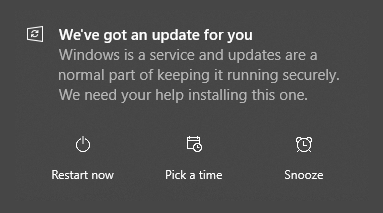Specify Engaged restart transition and notification schedule for updates
IT admins can schedule the period from anywhere between 0 to 30 days after the update becomes available. As a safeguard, there is a Snooze period available which can be 1 and 3 days. There is an additional setting called Deadline. The deadline means that after it is crossed, Windows Update will automatically execute a pending restart regardless of Active Hours. You can setup engaged restart transition by following these two methods: Before changing Registry entries, make sure to create a restore point. In case you end up doing something which causes a problem on the computer, you can always restore. 1] Set deadlines using Group Policy Editor
When you enable it, you have to configure the number of days for Transition, Snooze, and Deadline for Quality Updates and Feature Updates. The number of days that can be set between 2 to 30. Value for snooze can be between 1 to 3. Here is what each of these means:
Transition: Specify the timing before transitioning from Auto Restart to Engaged Restart (pending user schedule).Snooze: Specify snooze for Engaged Restart reminder notifications.Deadline: Specify the deadline before a pending restart will automatically be executed outside of active hours.
The last setting is what you need to change to specify the deadline before auto-restart for update installation. If you do not specify a deadline or if the deadline is set to 0, the PC won’t automatically restart and will require the person to schedule it before restart. Lastly, you should know that the below-mentioned policies will override the policy we mentioned above.
No auto-restart with logged on users for scheduled automatic updates installationsAlways automatically restart at the scheduled timeSpecify deadline before auto-restart for update installation.
2] Set deadlines using Registry Editor
There is a reason why I have explained so many things in the Group Policy section. When you enable the setting, it creates Registry entries. You can change the value of these to achieve the same configuration. So, if you want to do the same using Registry Editor, follow these steps:
Open Registry EditorNavigate toHKEY_LOCAL_MACHINE\SOFTWARE\Policies\Microsoft\Windows\Right-click on Windows, and create a new Key or Folder and name it WindowsUpdateThen create two DWORDSEngagedRestartDeadlineEngagedRestartDeadlineForFeatureUpdatesEnter a value between 2 to 30 after you choose Decimal radio button.
If you want to configure Transition and Snooze, create the following DWORD at the same place, and set the value as you see in the Group Policy-
EngagedRestartSnoozeScheduleEngagedRestartSnoozeScheduleForFeatureUpdatesEngagedRestartTransitionScheduleEngagedRestartTransitionScheduleForFeatureUpdatesSetEngagedRestartTransitionSchedule
We hope the steps were easy to follow, and you were able to specify engaged restart transition to make the user to schedule update using Group Policy and Registry Editor.

